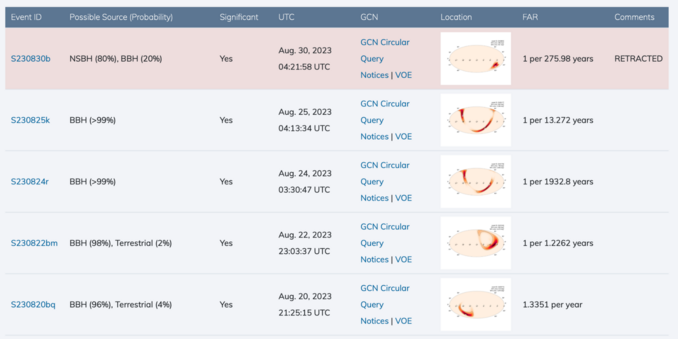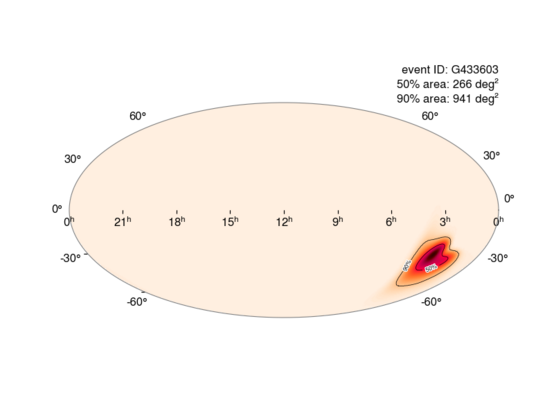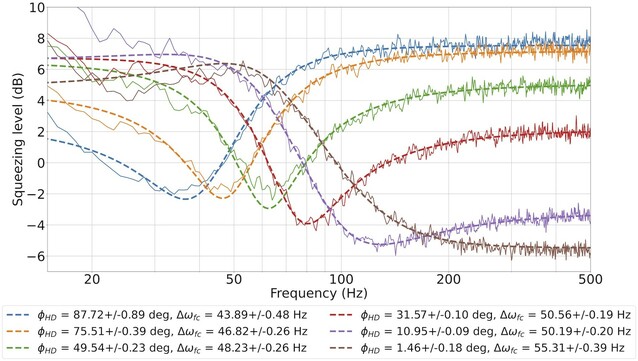MPI for Gravitational Physics · @mpi_grav
457 followers · 610 posts · Server social.mpdl.mpg.deToday, the 4th observing run (O4) of the gravitational-wave detectors has been running for 110 days.
So far, 37 “significant signal candidates” have been announced.
This means that there is a new possible gravitational-wave signal about every three days. Not all candidates will be real, but neither will all signals be found in this “online” analysis. It remains exciting!
All candidates: https://gracedb.ligo.org/superevents/public/O4/
Knowledge Zone · @kzoneind
309 followers · 1870 posts · Server mstdn.socialScientists Discover A #Climate #TippingPoint Could Be Far Worse Than We Thought : Medium
Tidal forces carry the #Mathematical #Signature of #GravitationalWaves : Tech Review
Have we overestimated the number of #Stars in the #Universe? : Big Think
Check our latest #KnowledgeLinks
#knowledgelinks #universe #stars #gravitationalwaves #signature #mathematical #tippingpoint #Climate
MPI for Gravitational Physics · @mpi_grav
454 followers · 605 posts · Server social.mpdl.mpg.deNeue Multi-Messenger-Astronomie-Veröffentlichung von Astronom:innen und @LIGO@astrodon.social-Virgo-KAGRA-Froschenden auf dem arXiv veröffentlicht: „A Joint Fermi-GBM and Swift-BAT Analysis of Gravitational-Wave Candidates from the Third Gravitational-wave Observing Run“
📄 https://arxiv.org/abs/2308.13666 [Veröffentlichung]
📘 https://www.ligo.org/science/Publication-O3GammaRayFollowUp/ [Hintergrund und Erklärungen in der „Science Summary“]
#gammarayburst #gravitationalwaves
MPI for Gravitational Physics · @mpi_grav
454 followers · 605 posts · Server social.mpdl.mpg.deNew multi-messenger astronomy paper by astronomers and @LIGO@astrodon.social-Virgo-KAGRA scientists out on the arXiv: “A Joint Fermi-GBM and Swift-BAT Analysis of Gravitational-Wave Candidates from the Third Gravitational-wave Observing Run”
📄 https://arxiv.org/abs/2308.13666 [paper]
📘 https://www.ligo.org/science/Publication-O3GammaRayFollowUp/ [background and explanations in science summary]
#gammarayburst #gravitationalwaves
Universe Today · @universetoday
5 followers · 13 posts · Server m.universetoday.comIt's Time for a Gravitational Wave Observatory in the Southern Hemisphere
All current and planned gravitational wave observatories are located in the northern hemisphere, in the US, India, Europe, and Japan. Even the next-generation observatories like Cosmic Explorer 40-km and the Einstein Telescope will be in the north. But a telescope in the southern hemisphere would provide a much larger baseline, allowing the detection of fainter gravitational waves. A new paper makes the case for building an observatory south of the equator.
MPI for Gravitational Physics · @mpi_grav
451 followers · 600 posts · Server social.mpdl.mpg.deThe 4th observing run (O4) of @LIGO, Virgo, KAGRA and GEO600 has been ongoing for 14 weeks.
So far, 35 significant candidate signal (https://gracedb.ligo.org/superevents/public/O4/) have been found. Not all of them have to be real, but there will also be faint undetected signals.
There is a new signal candidate every 2.8 days.
For comparison, there were also 35 signals in the 2nd half of the previous observing run (O3b), but in 21 weeks – a new signal every 4.2 days.
MPI for Gravitational Physics · @mpi_grav
451 followers · 595 posts · Server social.mpdl.mpg.deWednesday starts with an exciting gravitational wave candidate from @LIGO. If real, it is likely from the rather rare merger of a neutron star with a black hole. The distance is about 700 million light-years. The sky position is fairly well constrained by observation with both LIGO detectors.
Fraser Cain · @fraser
3227 followers · 966 posts · Server m.universetoday.comIt's Time for a Gravitational Wave Observatory in the Southern Hemisphere
All current and planned gravitational wave observatories are located in the northern hemisphere, in the US, India, Europe, and Japan. Even the next-generation observatories like Cosmic Explorer 40-km and the Einstein Telescope will be in the north. But a telescope in the southern hemisphere would provide a much larger baseline, allowing the detection of fainter gravitational waves. A new paper makes the case for building an observatory south of the equator.
Benjamin Carr, Ph.D. 👨🏻💻🧬 · @BenjaminHCCarr
1014 followers · 2652 posts · Server hachyderm.io"Earlier this year, after 15 years of searching, scientists finally heard the background hum of low-frequency #gravitationalwaves that fill our #universe," writes Space.com
Scientists' recent detection of low-frequency gravitational waves may shed light on what's causing a constant rumble of ripples in the very fabric of #space and time. https://www.space.com/supermassive-black-holes-may-solve-mystery-universe-gravitationa-wave-hum
#gravitationalwaves #universe #space
MPI for Gravitational Physics · @mpi_grav
447 followers · 590 posts · Server social.mpdl.mpg.deOn Saturday, September 30, 2023, the @mpi_grav and the Institute for Gravitational Physics of @UniHannover invite you to visit the German-British gravitational-wave detector GEO600 near Sarstedt.
MPI for Gravitational Physics · @mpi_grav
437 followers · 584 posts · Server social.mpdl.mpg.deRead up on recent news and upcoming topics in gravitational-wave astronomy, featuring Pulsar Timing Arrays, @LIGO, Virgo, and LISA in this Scientific American article by @astrojonny:
#GravitationalWaves #Astronomy #BlackHoles #LISAMission #PulsarTimingArrays
#gravitationalwaves #astronomy #blackholes #lisamission #pulsartimingarrays
MPI for Gravitational Physics · @mpi_grav
437 followers · 584 posts · Server social.mpdl.mpg.deNew status from the current 4th joint gravitational-wave observing run (O4):
⌛ Since the start of O4: 89 days
🔢 Number of significant signal candidates: 32
➡️ There is a new signal candidate every 2.8 days.
At the end of the planned O4 runtime (20 months), there could be >200 candidates.
Not all candidates will be confirmed as signals after further analyses. But these should detect more signals not found so far.
Steve Dustcircle ⍻ · @dustcircle
154 followers · 4028 posts · Server mastodon.cloud#GravitationalWaves Ripping Apart Whole #Planets?
https://www.newscientist.com/article/2387387-could-a-gravitational-wave-rip-apart-an-entire-planet/
#gravity #cosmos #planet #universe
#gravitationalwaves #planets #gravity #cosmos #planet #universe
MPI for Gravitational Physics · @mpi_grav
426 followers · 577 posts · Server social.mpdl.mpg.deHappy Birthday, GW170817! Six years ago today, @LIGO and Virgo observed gravitational waves from merging neutron stars for the first time, and many other telescopes observed the electromagnetic radiation produced by the event.
Our press release about the event: https://www.aei.mpg.de/182193/first-observation-of-gravitational-waves-from-merging-neutron-stars
Numerical simulation: https://www.youtube.com/watch?v=V6cm-0bwJ98
#gw170817 #gravitationalwaves #binaryneutronstar
MPI for Gravitational Physics · @mpi_grav
423 followers · 574 posts · Server social.mpdl.mpg.deWant to stay up to date with the latest gravitational-wave signal candidates from @LIGO, Virgo, and KAGRA? Check out Chirp!
#gravitationalwaves #astronomy #chirp
Hari Tulsidas :verified: · @haritulsidas
246 followers · 1352 posts · Server masto.aiScientists have detected a background hum of low-frequency gravitational waves that pervades the universe. These waves are different from the ones produced by colliding black holes or neutron stars, which have been observed by LIGO and Virgo. The origin of this hum is unknown, but it could reveal new physics and exotic phenomena, such as supermassive black hole mergers or cosmic strings. #GravitationalWaves #Astronomy #Mystery https://www.scientificamerican.com/article/a-background-hum-pervades-the-universe-scientists-are-racing-to-find-its-source/?utm_source=flipboard&utm_content=HariTulsidas%2Fmagazine%2FMind+and+Matter
#gravitationalwaves #astronomy #mystery
MPI for Gravitational Physics · @mpi_grav
422 followers · 570 posts · Server social.mpdl.mpg.de📢 New selected research highlight: Next-level squeezed light for Advanced Virgo – researchers at @mpi_grav and Leibniz University Hannover help set up and characterize the frequency-dependent squeezed-light source
➡️ https://www.aei.mpg.de/1063452/next-level-squeezed-light-for-advanced-virgo
📰 https://journals.aps.org/prl/abstract/10.1103/PhysRevLett.131.041403 (Open Access)
#gravitationalwaves #squeezedlight #quantumoptics
DAIROKKAN. · @antoine
2 followers · 602 posts · Server mstdn.jp// #Astronomers are now seeking to pinpoint the origins of a new form of #gravitationalwaves : https://www.scientificamerican.com/article/a-background-hum-pervades-the-universe-scientists-are-racing-to-find-its-source/
#timeline #scientificamerican #repost #gravitationalwaves #astronomers
Dr. John T. Whelan · @jtwsma
41 followers · 28 posts · Server mathstodon.xyzAttending my first in person #JSM this week. It'll be speaking about searches for continuous gravitational waves Tuesday morning in the topic contributed session on "Pulling Signal out of Noise for Data-Driven Discoveries in Astronomy". #JSM2023 #GravitationalWaves #LIGO #Virgo #KAGRA
#kagra #virgo #ligo #gravitationalwaves #jsm2023 #jsm
Jim Donegan ✅ · @jimdonegan
1557 followers · 4653 posts · Server mastodon.scot#JuanMaldacena - What is #Spacetime?
https://www.youtube.com/watch?v=yHh3RmYCXWA&ab_channel=CloserToTruth
#Philosophy #PhilosophyOfScience #Science #Physics #PhilosophyOfCosmology #Cosmology #Expansion #Astrphysics #Relativity #Mass #Energy #GR #GeneralRelativity #Space #Time #GravitationalWaves #StringTheory #CloserToTruth #RobertKuhn
#RobertKuhn #CloserToTruth #stringtheory #gravitationalwaves #time #space #generalrelativity #gr #energy #mass #relativity #astrphysics #expansion #cosmology #PhilosophyOfCosmology #physics #science #philosophyofscience #philosophy #spacetime #juanmaldacena










